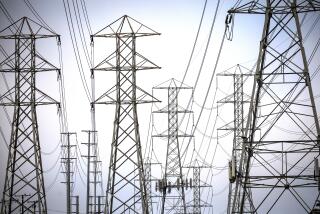Cool It! : When temperatures rise on the outside, remember the keys to controlling the climate on the inside: insulate and circulate.
- Share via
If you find that you’re not enjoying summer very much, join the club. Those who aren’t fortunate enough to live close to the ocean have had to endure triple-digit temperatures and humidity that makes the air stick to your skin as soon as you walk outside.
With air conditioning, life in this kind of season is livable. Without it, life can be insufferable. Yet thousands of homes in Orange County lack a cooling system, and many who have it use their air sparingly after seeing their last electricity bill.
A good central air system can cost $2,000 and up, which makes many people feel the need to endure these dog days. Getting through the rest of summer without wintry air may not be easy, but it can be done.
Basically, just remember two words when trying to cool down: insulate and circulate.
Doors and Windows
Insulation-wise, doors and windows are the weakest points in your home. All that separates you from the searing heat outside is a thin sheet of glass or a door that must be opened and closed periodically during the day. Short of boarding yourself in and living in the dark, you can try making these areas as climate-proof as possible.
Ideally, your home should have double-paned or storm windows, which create an insulating air pocket between the outdoors and indoors. However, the cost, which can be more than $200 per window, may not make them feasible.
Instead, make sure the window is properly caulked inside and out to prevent leaking air.
Of course, even though your window might be airtight, your house will heat up as the sun pours through the glass. Having trees or shrubbery outside the window is a natural way to keep out direct sunlight, but a quicker fix is to install a shade-producing awning outside the window.
At less than $10 per roll, perhaps the best cooling bargain is a reflective window film on the glass. “The darker the film, the less intense the sun will be inside,” says Debbie Mundt of College Glass & Mirror in Anaheim. “You’ll want to take a good look at the film and maybe test one of your windows to see if it’s too dark or light for your tastes.”
Reflective screens placed over windows can also be used to block the sun. “They come in fiberglass or aluminum, and they keep 70% to 80% of harsh sunlight from entering a room,” says Mundt. “It’s probably a little more effective than the film because it stops the heat before it reaches the glass.”
Check the weatherstripping around your doors and replace it if it’s worn or missing. A screen door that’s been outfitted with a reflective screen can also beat back the rays.
When it gets too stuffy inside, open doors and windows on the shady side of the house, because the air is probably slightly cooler there. In the morning and at night, keep the windows open to let the cooler outdoor air flush out the warmer indoor air.
Attack From Above
Even if you sealed up your doors and windows with slabs of concrete, your home would still get warm because of the intense heat that filters down from the roof. The exterior shingles or tiles can be 20 to 30 degrees hotter than the air temperature, and this warms up the attic space.
If your attic insulation is skimpy or if it has numerous empty patches, the heat will have an easier route down into the house. “Use a rolled insulation with a rating of at least R-30,” says Jim Gorman of Rancho Lumber in Westminster. “This is an easy thing for someone to do themselves. Check to see if the space between your joists is 24 or 16 inches, then get the appropriate size. It’s rolled out on top of blown-in insulation, and it will make a noticeable difference in both heating and cooling.”
Attic areas have vents to disperse the built-up heat, but make sure these are clean and free of obstructions.
The best way to cool hot attics is through an attic fan or turbine vent. Turbines are those silvery globes that resemble spinning chef’s hats often seen on top of buildings. Unlike a louvered gable vent, the turbine sits near the top of the attic--where the hottest air is--and even a mild breeze is enough to make it spin and draw the air out.
“These can work very well, but if you’re considering a turbine vent, get the best-quality model you can find,” says Gorman. “Bearings can rust on cheaper models, which keeps them from turning.”
Expect to pay around $25 per 80-square-feet of insulation and $30 to $50 for a turbine fan, plus installation.
Hitting the Fan
When the temperature rises, look for big displays of fans in stores. Stand in front of one those shiny whirlers for a few minutes and the store may have what’s known as an impulse buy. You picture yourself sitting at home with those blades churning that cool breeze on your face.
The reason that breeze feels good, however, is because it’s air conditioned. At home, that breeze can get pretty warm and may not be so comfortable.
“The whole purpose of a fan is to use your body’s natural cooling system,” says Bob Owenby of A-1 Fans in Anaheim. “It gets the air moving to help evaporate your perspiration, which cools you down. It may not make your house cooler, but it will help you feel more comfortable.”
Ceiling fans, which start at around $60, continue to be a popular and decorative method to get your air circulating. Some people find they’re more effective than a table fan. “The advantage of a ceiling fan is that it pulls the warmer air down from the ceiling and cools it by mixing it with the air near the floor,” says Owenby.
Central Air Alternatives
If you have friends or relatives in the Southwest, they may be raving about their heat pumps.
“These work by extracting heat from the house rather than putting cool air in,” says Tom Houlihan of Orange County Appliance Parts in Garden Grove. “However, they tend to work best in the dry heat climate of the desert.”
The same goes for evaporative coolers, which draw air over a moist filter. “The air becomes cooler, but it also adds humidity to the house, which is acceptable in the desert but not too great in climates like ours,” says Houlihan.
You can get a taste of central air, at least in a room or two of your house, by installing a wall air conditioner. “You can find that by investing $300 to put an air conditioner in your bedroom window, summer becomes bearable because you don’t have to sleep in the heat,” says Houlihan.
Running it only at those times when you’re in the room saves on electricity costs, and if you can do the installation yourself you could save even more. “If you’re lucky enough to have one of the old-fashioned windows that you can plug an air-conditioning unit into, installation’s a breeze,” says contractor Ed Caro of Santa Ana. “If not, you may have to knock a hole in the wall, which can be tricky if you haven’t done it before.”
Caro, who doesn’t have air conditioning in his house, has a less conventional way to cool down during heat waves. “I just stock up on sodas and run some fans over a couple tubs of ice. Maybe it’s all in my head, but it works.”
More to Read
Sign up for The Wild
We’ll help you find the best places to hike, bike and run, as well as the perfect silent spots for meditation and yoga.
You may occasionally receive promotional content from the Los Angeles Times.






